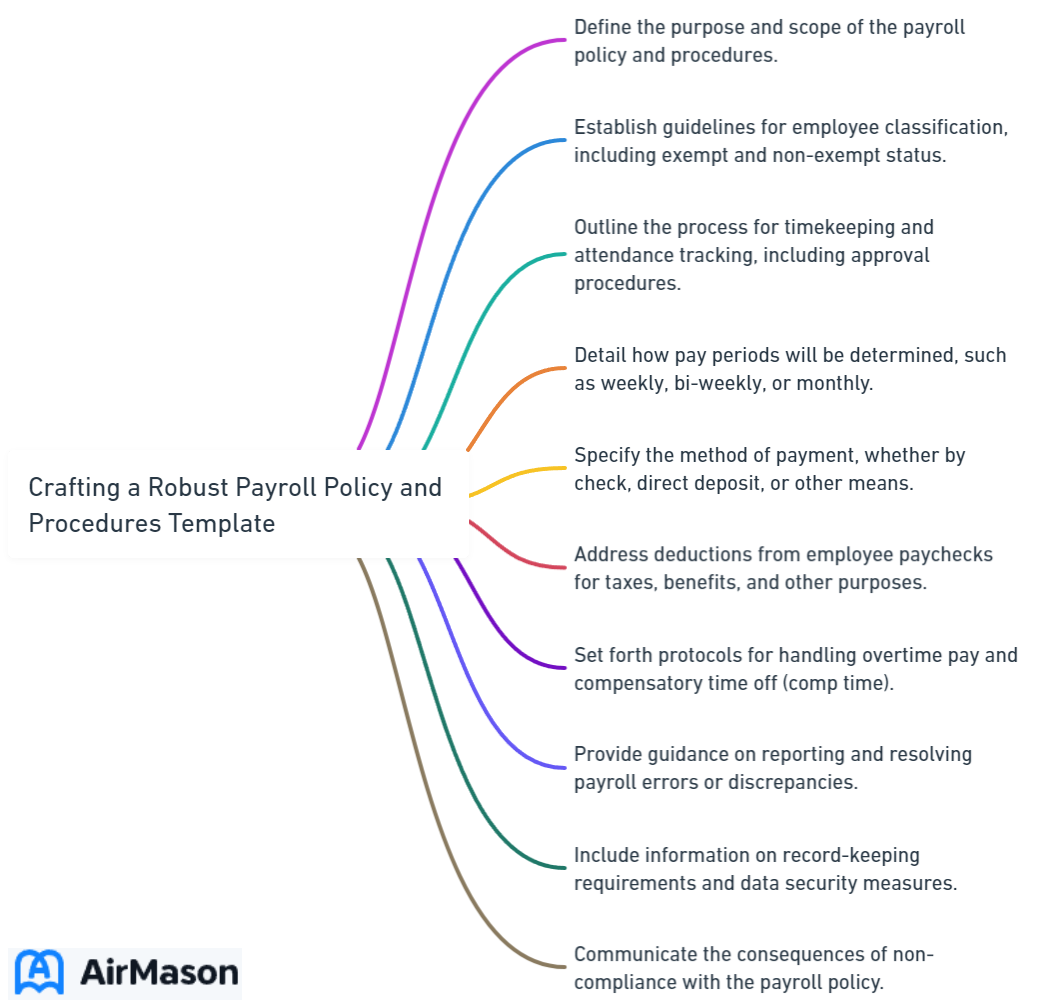
In today’s fast-paced business world, having a well-defined payroll policy and procedures is crucial for organizations of all sizes. It not only ensures that employees are paid accurately and on time, but also helps maintain compliance with various regulations. In this blog post, you’ll gain valuable insights into crafting a robust payroll policy and procedures template that will serve as a solid foundation for your company’s payroll operations.
Key Takeaways
- Understanding payroll policies and procedures is essential for organizations to ensure compliance with regulations.
- A payroll policy template should include components such as employee information, payment structure, deductions and benefits.
- Periodic review and updates of the payroll policy are necessary to maintain accuracy in accordance with evolving regulations.
Understanding Payroll Policies and Procedures
Payroll policies and procedures are the backbone of any organization, as they guarantee that employees are paid accurately and promptly, preserving employee morale and upholding business financial stability. A comprehensive payroll policy may encompass a wide range of topics, such as:
- Final paychecks
- Holiday pay
- Salary adjustments
- Pay increases
- Salary advances
- Overpayments
- W-2 distribution
- Expense reimbursement
These policies and procedures ensure compliance with various regulations, such as professional tax, and provide a clear framework for employee compensation.
Alternatively, payroll processing involves a series of steps such as calculating employee wages, making necessary deductions like the employee provident fund, and distributing the net pay to the employees. The payroll department, often headed by a payroll administrator, is responsible for planning the payroll process step-by-step to guarantee proficient payroll management. Adhering to a payroll policy template facilitates the expedient distribution of salaries to employees, enabling organizations to evade legal difficulties and unnecessary penalties, such as those related to the Fair Labor Standards Act.
Payroll Policies
A payroll policy outlines the procedure for compensating employees, including the management of salaries, record-keeping of hours worked, methods of payment, and payment timelines. It plays a crucial role from the employee hiring process onwards and is applicable to all personnel regardless of their standing within the organization. Key components of payroll policies include payment schedules, timekeeping, and employee classifications.
When formulating payroll policies, one needs to take into account factors like pay period, pay dates, and the provision of direct deposit. Equally important are policies regarding overtime, including permitted overtime, hours constituting overtime, and the approval process for overtime. Moreover, policies need to cover breaks and meal periods, in compliance with federal and state regulations.
Payroll Procedures
Payroll procedures are defined by a set of guidelines, controls, and policies. These protocols ensure correct payments to employees. These procedures facilitate payments, oversee expenditures, and avert regulatory problems. The employee data must first be validated before it is inputted into the payroll system. After that, taxes and deductions are automatically and manually adjusted to calculate the resulting net pay.
The final step in the monthly payroll process involves:
- Responding to any inquiries regarding salaries from employees in a satisfactory manner.
- Processing statutory remittances.
- Making the necessary accounting entries to record payroll costs in the books of accounts.
Payroll procedures ensure that customary taxes, such as federal and state income tax deductions, are withheld from employee wages.

Key Components of an Effective Payroll Policy Template
A well-designed sample of HR policy for payroll should contain the following information:
- Employee compensation
- Deductions and benefits
- Timekeeping and attendance
- Payroll processing
- Compliance with applicable laws and regulations
By adhering to a payroll policy template, organizations can ensure that employees are paid accurately and promptly, thus avoiding legal difficulties and unnecessary penalties.
To develop a thorough payroll policy template, it is important to incorporate key elements such as employee information, payment structure, and deductions and contributions. These components will be discussed in greater detail in the following subsections.
Employee Information
The collection and maintenance of employee data is an integral part of an effective payroll policy template. This includes personal details, tax information, and employment status. The payroll schedules, which refer to the frequency with which employees receive their remuneration, should also be included in this section.
Timekeeping and attendance policies are essential for accurately calculating employee wages and ensuring adherence to labor laws. Wage and salary structures, which may include:
- Hourly wages
- Salaries
- Bonuses
- Other forms of compensation
Should also be outlined in the employee information section.
Moreover, it is important to give details about deductions and withholdings, including taxes and insurance premiums.
Payment Structure
The payment structure, a fundamental element of a payroll policy template, details the multiple aspects of employee compensation, including:
- Basic salary
- Allowances
- Bonuses
- Overtime pay
Some allowances may be eligible for full or partial tax exemptions, so it’s essential to include these details in the payment structure section.
Travel reimbursements, if incorporated into the salary, should also be mentioned in this section. In addition, it is important to provide information about investment declarations, which can supplement the employee’s salary structure.
Deductions and Contributions
Deductions and contributions are amounts that are subtracted from an employee’s gross pay or added to their pay on a regular basis. This section of the payroll policy template should detail the different types of deductions and contributions, such as:
- Professional tax
- Provident fund
- Social security
- Insurance premiums
It’s important to verify that these deductions and contributions are in line with the pertinent laws and regulations to protect the organization from potential legal and financial liabilities.

Creating a Payroll Procedures Template
For any organization, the development of a payroll procedures template that backs the payroll policy and assures seamless payroll processing is crucial. A well-designed HR policies and procedures manual template should encompass information pertaining to:
- The calculation of employee wages
- Deductions
- Tax withholdings
- Other payroll-related tasks
The intent of a payroll procedures template is to furnish a point of reference for HR and payroll personnel to guarantee uniformity and precision in payroll processing.
In creating an efficient payroll procedures template, it’s important to have regard to aspects like payroll processing steps, compliance and reporting, along with system and software considerations. These will be discussed in greater detail in the following subsections.
Payroll Processing Steps
The sequence of tasks involved in payroll processing is critical to the successful implementation of your payroll policy and procedures. These tasks include:
- Collection of employee information and time records
- Determining gross wages
- Deducting taxes and other withholdings
- Determining net pay
- Preparing payroll reports
- Distributing paychecks or processing direct deposits.
By outlining these steps clearly in your payroll procedures template, you can ensure that your payroll process runs smoothly and efficiently. In addition, this will help minimize errors and potential compliance issues, ensuring that employees are paid accurately and on time.
Compliance and Reporting
Adhering to applicable federal and state laws is of utmost importance in payroll procedures. Your payroll procedures template should highlight the need for maintaining accurate payroll records and reports, as well as emphasize the importance of complying with relevant laws and regulations.
This includes compliance with:
- labor laws
- tax regulations
- recordkeeping
- payment timing
- wage deductions
- employee classification
- reporting requirements
By including these compliance and reporting requirements in your payroll procedures template, you can ensure that your payroll operations remain transparent, accurate, and accountable.
System and Software Considerations
Incorporating technology into your payroll processes can greatly improve efficiency and streamline operations. When creating your payroll procedures template, it’s important to consider the following system and software considerations:
- Compatibility
- Scalability
- Security
- Integration
- Reporting and analytics
- User-friendliness
- Support and updates
- Compliance
- Backup and recovery
- Cost
By evaluating and selecting the appropriate payroll software and systems, you can automate manual tasks, minimize errors, and provide real-time data and analytics that will assist in making informed decisions. Furthermore, utilizing technology can help ensure that your payroll procedures are in compliance with the ever-changing legal and regulatory landscape.

Customizing Your Payroll Policy and Procedures Template
Tailoring your payroll policy and procedures template to fit the distinct needs and requirements of your business is vital for its successful execution. This may involve considering the size of your organization, the type of employees, and the industry in which your business operates. Regularly reviewing and updating your template to reflect any changes in your business or the legal and regulatory environment is also crucial for maintaining compliance.
To help you customize your payroll policy and procedures template, the following subsections will provide tips on incorporating company-specific policies, as well as ensuring compliance with legal and regulatory requirements in your jurisdiction.
Company-Specific Policies
Incorporating company-specific policies into your payroll policy and procedures template is essential for addressing the unique needs of your organization, especially if you are design HR policies for a small business. Because the scope of operations vary with each business. These policies may include:
- Leave management
- Expense reimbursement
- Employee benefits
- Overtime pay
- Bonuses and incentives
- Payroll deductions
- Any other specific regulations or procedures that are unique to your company’s payroll operations.
Ensuring that these company-specific policies are clearly articulated and easily comprehensible is crucial for successful implementation. Moreover, periodically reviewing and updating these policies will help maintain their relevance and ensure adherence to any changes in company regulations or external factors that may impact payroll administration.
Legal and Regulatory Requirements
Tailoring your payroll policy and procedures template to comply with relevant laws and regulations in your jurisdiction is vital for maintaining compliance and avoiding potential legal and financial liabilities. This may involve adhering to:
- Labor laws
- Tax regulations
- Recordkeeping requirements
- Payment timing requirements
- Wage deductions
- Employee classification requirements
- Reporting requirements
By conducting regular audits and updates of your payroll policy and procedures template, you can ensure that it remains current and compliant with any changes in the legal and regulatory landscape. Additionally, this will help you identify and rectify any errors or inconsistencies in your payroll policy, ensuring accuracy and uniformity in your payroll procedures.
Implementing and Updating Your Payroll Policy and Procedures
After crafting and personalizing your payroll policy and procedures template, it’s necessary to put it into action and revise it regularly to guarantee continuous compliance and effectiveness. This involves:
- Evaluating your current payroll processes
- Recognizing areas for improvement
- Determining the most effective way to implement the new policy and procedures
The following subsections will discuss the importance of employee training and communication, as well as the need for periodic review and updates to keep your payroll policy and procedures current and compliant.
Employee Training and Communication
Imparting knowledge to your employees about your payroll policies and procedures is key for them to understand and follow these guidelines. This can be achieved through training sessions, emails or memos, and posting notices in common areas. By providing clear and comprehensive information on your payroll policies and procedures, you can help minimize errors and potential compliance issues.
Maintaining open lines of communication regarding any changes to your payroll policies and procedures is also essential. This helps ensure that employees are aware of any modifications and can adhere to the updated policies and procedures, thereby reducing errors and potential compliance issues.
Periodic Review and Updates
Performing routine audits and updates of your payroll policy and procedures is important for keeping them relevant and in compliance with the constantly evolving legal and regulatory landscape. By periodically reviewing your policy and procedures, you can identify and rectify any errors or inconsistencies, ensuring accuracy and uniformity in your payroll operations.
Additionally, regular reviews and updates will help you accommodate any changes in your organization’s payroll processes or external factors that may impact payroll administration. This proactive approach will ensure that your payroll policy and procedures remain current and effective in managing your organization’s payroll operations.
Summary
In conclusion, crafting a robust payroll policy and procedures template is essential for any organization, as it ensures accuracy and compliance in payroll operations. By understanding the key components of payroll policies and procedures, creating a comprehensive template, and customizing it to suit your unique business needs, you can streamline your payroll processes and avoid potential legal and financial liabilities.
Remember, regularly reviewing and updating your payroll policy and procedures, as well as ensuring proper employee training and communication, will help maintain ongoing compliance and effectiveness. With a well-defined payroll policy and procedures template in place, your organization will be better equipped to manage employee compensation and adhere to the ever-changing legal and regulatory landscape.
Frequently Asked Questions
How do you write a payroll policy and procedure?
Writing a payroll policy and procedure involves outlining how often employees will be paid, pinpointing the payday date and times, describing the payment methods available, pre-payroll preparations, procedure forms, timekeeping procedures, data entry processes, wage and deduction processing, approval process, report handling standards and post-payroll procedures.
These topics should be addressed in the policy and procedure document. Outlining how often employees will be paid is important to ensure that employees are aware of when they will receive their wages. Payday dates and times should be clearly stated in the policy and procedure document. Payment methods available should also be outlined, such as direct deposit, check, or cash.
Pre-payroll preparations should be outlined in the document.
What should be included in a payroll policy?
A payroll policy should include all payroll deductions for taxes, benefits and other fees, with detailed explanations. It should also cover pre-tax deductions and contributions, as well as local, state and federal taxes, and post-tax deductions and contributions such as wage garnishments or union dues.
What are examples of payroll procedures?
Payroll procedures typically involve gathering time card information, computing gross pay, calculating payroll taxes and deductions, calculating net pay, approving payroll, paying employees and distributing pay stubs.
What is the importance of having a well-defined payroll policy and procedures for businesses?
Having a clear payroll policy and procedures is essential for businesses as it ensures employees receive accurate and timely payment, preserves employee morale, safeguards financial stability, and ensures compliance with regulations.
Creating a comprehensive payroll policy and procedures manual is the best way to ensure that all employees are aware of their rights and responsibilities when it comes to payroll. It should include information on pay periods, pay rates, overtime, deductions, and other important topics.
The.
How can I customize my payroll policy and procedures template to suit my business needs?
Customize your template by including company policies and ensuring compliance with legal and regulatory requirements in your jurisdiction.
This will help you create a document that is tailored to your specific needs and will help you stay compliant with the law.
